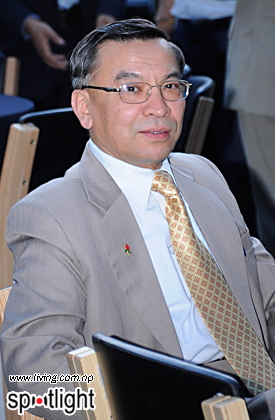Exactly 60 years ago, Nepal and China established diplomatic relation. In fact, the two countries had official relations since 7th century, when King Narendra Deva accepted several missions from the Tang Dynasty Emperor of China. Nepal had also sent similar missions with lavish gifts to please the Chinese rulers of the time. That was the time when both the countries discovered the route of Kerung to Lhasa and further to China. Earlier, the Chinese pilgrims and business people used to visit India via central Asian and Kashmir route. The Kerung route turned out to be the shortest for the Chinese to connect with India. During the Malla period, Nepalese currency used to be the legal tender in Tibetan region. In return for our currency, Tibet used to pay in gold. This and a profitable Tibet trade made the medieval Nepal a rich country in the region. This was the same fortune which was used to build hundreds of temples with beautiful statutes and intricate carvings in the Nepal Mandala.
During the intervening period, Nepal and Tibet had fought several wars which ultimate resulted in peace treaties. One of such treaties, called Kerung Treaty of 1789 had already provided for a Nepali Vakil office (diplomatic representative) in Lhasa. The Lichhavi kings and the Malla kings had sent several emissaries to the court of Chinese emperor also. The contact between two countries was mainly affected after the end of Qing dynasty in China in 1911 and the heavy engagement of Rana rulers with the British rulers of their Indian colony. However, with the change of time, even Rana rulers intended to restore diplomatic relations with China.
With the imminent departure of British from India, the Ranas wanted to find an alternative diplomatic avenue. Prime Minister Padma Shamsher had sent a high level emissary General Krishna Shamsher and his team to the then Chinese capital of Nanjing in May 1947. The General from Nepal met the Chinese Generalissimo Chiang Kaishek and presented with lavish gifts. Chiang was so pleased that he sent his own special aircraft for the return trip of the Nepalese via India. However, he could not do more in establishing relations with Nepal as he was already deep in trouble with the civil war in China. With his fall in 1949 and Ranas’ fall in 1951, the scenario completely changed. Although not successful with China, the Ranas established diplomatic relations with USA and France before the 1951 revolution, besides the earlier established relations with UK and India.
After the 1951 revolution, Nepal was said to have opened to the outside world. But in real terms, Nepal could not extend its diplomatic ties with any other countries for more than four years. So much so that Nepal even did not have its independent Post and telecommunications system for a long time so as to directly contact third countries. There were voices for establishment of diplomatic relations with China mainly from the Praja Parishad party and then banned Communist party of Nepal. Some of the leaders of the Nepali Congress like Matrika Koirala were not very keen on this. But when they held their national congress, the voice for closer relations with China came very strongly and it passed a motion to that effect. In 1954, King Tribhuvan became badly sick and later died in Zurich, Switzerland in March 1955. From his sickbed, he had handed over most of his authorities to young Crown Prince Mahendra. The Prince had new ideas for the future of Nepal. Meanwhile, on 23rd September 1954, Premier Zhou Enlai made a statement in the Chinese People’s Congress in Beijing stating China’s readiness to establish diplomatic relation with Nepal on the basis of equality. Nepal officially welcomed the statement. But the progress was too slow under M.P. Koirala’s leadership, which was finally dismissed by the Crown Prince on 2 March 1955, eleven days before the death of Tribhuvan. On 14th April 1955, the new king had formed a five-member Royal Advisory Government.
Around same time, Nepal was to participate in the Bandung Conference of Afro-Asian countries convened by the “Colombo Power” countries of Burma, Ceylon, India, Indonesia and Pakistan. China was to be represented by a high level delegation led by Premier Zhou. The Nepali delegation was headed by the Foreign Secretary, Major General Suvagh Jung Thapa and Education Secretary Ram Prasad Manandhar was the alternate team leader. The team was entrusted by the king to discuss further with Premier Zhou on the work related to diplomatic relations. From then onwards there were hectic activities with the delegation of Chinese diplomats arriving in Kathmandu in late July 1955. The negotiations between two countries were very intensive and going into late hours and it was kept top secret.
The king allowed the special communications system available inside the Royal Palace to be used by the Chinese delegates to consult their headquarters in Beijing for every issue of negotiations at various stages to maintain secrecy. After 5 days of talks, the historical agreement to establish diplomatic relations between two countries was signed on the 1st August 1955. Signing from the Nepali side was the Principal Royal Advisor Sardar Gunja Man Singh and from China, the ambassador Yuan Zhongxian.(Sardar Gunja Man happened to be the grand-uncle of present DPM Prakash Man Singh). From then on, the relations between two countries is based on the Five Principles of Peaceful Coexistence or the Panchasheela. On the second August, both countries appointed their respective ambassadors and on the 3rd August, the Chinese ambassador presented his credentials before the King. The ambassador also made a statement about the relations between two countries on Radio Nepal on 6th August and left the capital on 8th August with a warm send off including a 19-gun salute.


